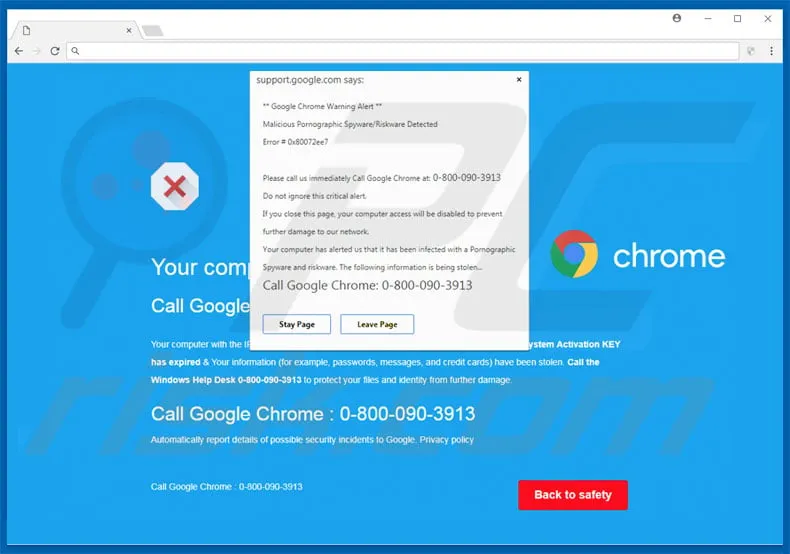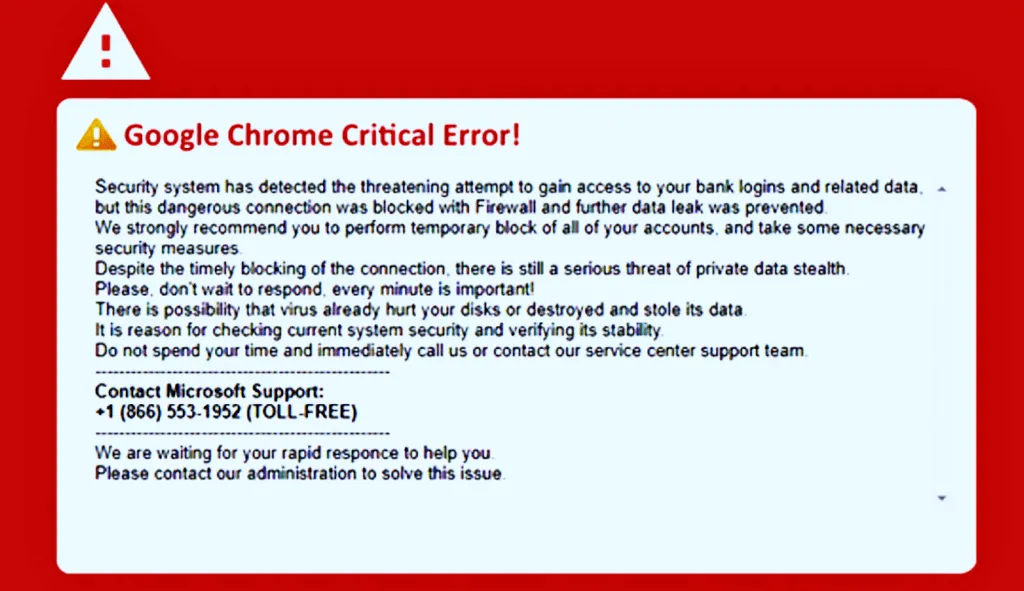How to Avoid Falling for Fake Chrome Error Messages
Have you ever been browsing the internet and suddenly a pop-up appears claiming that your computer has been compromised? Or maybe you’ve received a warning message from Google Chrome about a virus on your device? These types of fake error messages can be quite alarming and may even lead you to take actions that can harm your computer or compromise your personal information.
Unfortunately, cybercriminals have become increasingly clever in tricking users into falling for these fake error messages. They use scare tactics and convincing design to make it seem like your computer is at risk. In reality, these errors are often just a ploy to get you to click on malicious links or download harmful software.
This article will delve into the world of fake Chrome error messages and how you can protect yourself from falling for them. We’ll cover six main topics in detail, including the types of fake error messages, how they can affect your computer, and steps you can take to avoid them.
Types of Fake Chrome Error Messages

Fake Chrome error messages come in various forms, each with the goal of convincing you that your computer is in danger. Here are some of the most common types of fake error messages you may encounter while browsing the internet:
“Your Computer Has Been Compromised” Pop-ups
One of the most common forms of fake error messages is the pop-up that claims your computer has been compromised. These pop-ups usually come with a loud alarm sound, making them hard to ignore. They may also use urgent language, such as “Critical Security Alert” or “Your System Is Infected.” The goal of these pop-ups is to scare you into clicking on the link provided or downloading a supposed anti-virus software.
Phishing Scams
Phishing scams are another type of fake error message that often targets unsuspecting users. These scams use emails or websites that mimic legitimate companies to trick you into providing personal information, such as login credentials or credit card details. They often claim that there’s an issue with your account and that you need to verify your information or risk losing access.
Fake Tech Support Scams
Fake tech support scams involve a pop-up or phone call claiming to be from a reputable tech company, such as Microsoft or Apple. They may tell you that there is a problem with your computer and that they can help you fix it for a fee. These scams can be quite convincing, as the scammers may have access to your browsing history and use it to make their claims seem more legitimate.
“Your Chrome Browser Is Out of Date” Messages
Another common type of fake error message is the one that claims your Google Chrome browser is out of date. These messages may come in the form of a pop-up or appear on a website you’re visiting. They usually include a download link for what seems like an update to your Chrome browser. However, clicking on these links can lead to malicious software being installed on your device.
How Fake Chrome Error Messages Can Affect Your Computer
Fake Chrome error messages are not just annoying; they can also have serious consequences for your computer and personal data. Here are some ways these messages can harm your device:
- Malware: Clicking on the links provided in fake error messages can lead to the installation of malware on your computer. These programs can cause damage to your device, steal your personal information, or give hackers remote access to your system.
- Phishing: As mentioned earlier, phishing scams can also come in the form of fake Chrome error messages. If you fall for these scams and provide your personal information, you may become a victim of identity theft or fraud.
- Ransomware: Some fake error messages may claim that your computer has been infected with ransomware and that you need to pay a sum of money to remove it. These messages are often accompanied by a countdown timer, adding to the urgency and making users more likely to fall for the scam.
- Tech Support Scams: Fake tech support scams can be costly, as they often involve paying a fee for a service that is not needed. In some cases, the scammers may have remote access to your computer and can install malicious software or steal sensitive information.
- Malicious Software Installation: Some fake error messages may trick you into downloading and installing what seems like a legitimate program. However, these downloads can actually contain malware or spyware that can harm your device or compromise your data.
How to Avoid Falling for Fake Chrome Error Messages

Now that we’ve covered the types and potential consequences of fake Chrome error messages, let’s discuss how you can avoid falling for them in the first place. Here are some steps you can take to protect yourself:
Enable Pop-up Blockers
One of the simplest ways to prevent fake pop-ups from appearing on your screen is to enable pop-up blockers on your browser. Most browsers have this feature built-in, and you can usually find it in the settings menu. By enabling pop-up blockers, you can prevent most fake error messages from appearing while you’re browsing the internet.
Be Wary of Urgent Language and Alarming Sounds
As mentioned earlier, many fake error messages use urgent language and loud alarm sounds to catch your attention. If you see a pop-up that claims your computer has been compromised or infected with a virus, try to stay calm and assess the situation logically. Do not panic and rush to click on any links or download any software without verifying the legitimacy of the message.
Carefully Check the URL of the Website
Phishing scams often use websites that mimic legitimate companies to trick users into providing personal information. To avoid falling for these scams, make sure to check the URL of the website you’re on before entering any sensitive information. Look for small differences, such as misspelled words or added numbers, that may indicate that the website is not legitimate.
Do Not Provide Personal Information Unless Necessary
If you receive an email or pop-up claiming that there’s an issue with your account and you need to verify your information, be cautious. Legitimate companies will never ask you to provide personal information via email or pop-ups. If in doubt, log into your account directly through the company’s official website instead of clicking on any links provided.
Keep Your Browsers and Software Up to Date
As mentioned earlier, some fake error messages claim that your Chrome browser is out of date and provide a download link for what seems like an update. To avoid falling for this scam, make sure to regularly update your browsers and software from their official websites only. Avoid downloading updates from suspicious sources or by clicking on links provided in pop-ups.
Use Anti-virus Software
Having anti-virus software installed on your computer is crucial in protecting it from malicious software and cyber threats. Make sure to keep your anti-virus definitions up to date and run regular scans to detect and remove any potential threats. This can help prevent fake error messages from causing harm to your device.
What to Do if You’ve Fallen for a Fake Chrome Error Message

If you’ve already fallen for a fake Chrome error message and clicked on a malicious link or downloaded harmful software, here are some steps you can take to mitigate the damage:
- Disconnect from the internet: As soon as you realize you’ve been tricked, disconnect your device from the internet. This can prevent any further communication between your computer and the malicious source.
- Scan Your Computer: Run a full scan of your computer using your anti-virus software to detect and remove any malicious programs.
- Change Passwords: If you’ve entered any passwords on a phishing website, change them immediately. Make sure to use strong and unique passwords for each of your accounts.
- Contact Your Bank: If you’ve entered credit card information on a fake website, contact your bank immediately and report the issue. They can help you monitor your account for any suspicious activity and take necessary actions to protect your finances.
- Seek Professional Help: If you’re unsure if your computer has been compromised or are having trouble removing malicious software, seek professional help from a reputable tech support company.
Conclusion
Fake Chrome error messages can be quite convincing, but with vigilance and caution, you can avoid falling for them. Make sure to enable pop-up blockers, be wary of urgent language and alarming sounds, and carefully check the URL of websites before entering personal information. Keep your browsers and software up to date, use anti-virus software, and seek professional help if needed. By following these steps, you can protect your computer and personal information from falling into the hands of cybercriminals.